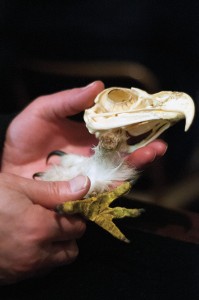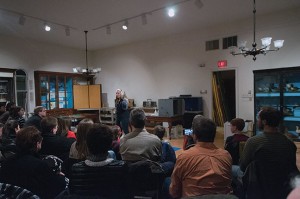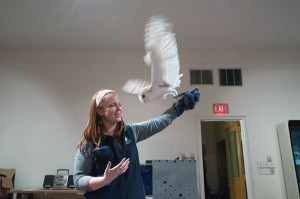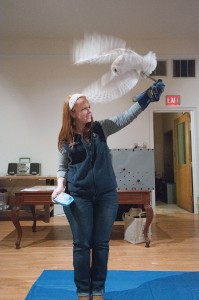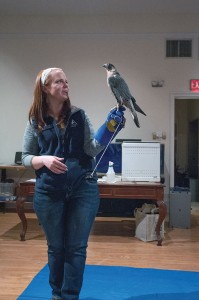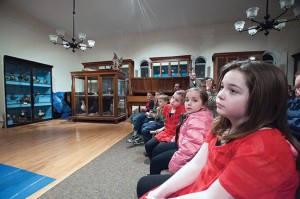Have you ever looked into the deep, black, bottomless eyes of a Barn Owl? How about being stared down by a powerful Peregrine Falcon? Chances are, you’ve never even been close enough to make eye contact with one of these solitary birds of prey – that is, unless you were at the Marion Natural History Museum last Friday evening when Emily George of Mass Audubon’s Blue Hills Trailside Museum in Milton brought some of her feathery friends to Marion to meet a full house of spectators, eager to learn all about the nature of the raptor.
The word raptor comes from the Latin rapere, which means, “to seize.” Some commonly known raptors – or birds of prey – are eagles, hawks, ospreys, herons, and falcons. They hunt animals for food, using their keen eyesight to spot their prey from far away, and using their sharp, relentless talons to snatch it up and kill it.
Ms. George offered an enormous amount of information regarding birds of prey, and the audience had a plethora of interesting questions for George throughout the program.
Do you know how to distinguish Red-Tailed Hawks from other types of hawks as they soar high above overhead? The tails of Red-Tailed Hawks do not turn red until they are about two years old, so one surefire way to tell the difference is that Red-Tailed Hawks have a black “comma” shape underneath, by the wrist bone of the wing, which you can see as they fly above.
Snowy Owls have invaded Massachusetts this year, and according to George, this year had the highest number of Snowy Owls ever recorded in the state. Where can Snowy Owls be found most frequently in Massachusetts? Logan Airport, believe it or not, said George. The owls have foregone migrating because there are lemmings-a-plenty around here, and mating activity is up, leading to a higher population of Snowy Owls.
With a Barn Owl resting on her arm, George told the group about how the owl was found in a nest on a farm; the adult owls had abandoned the nest, most likely due to fisher cats. The owl was brought to the Trailside Museum, where he lives permanently, but the same does not always go for abandoned baby owls.
George said, most often, workers from the museum take the babies and try to find them homes in their natural environment, with a new unsuspecting set of adoptive parents. They look for a nest with babies about the same size as the abandoned one and gently plop it into the nest with the others, along with a few snacks for their trouble. When the parents get back, said George, they won’t even realize they just adopted another baby.
“It’s kind of a mean trick we play,” said George. “Owls can’t count … and owls can’t smell.”
It is actually a myth that birds can smell the scent of a human, the reason many of us are told not to touch a baby bird should it fall from a tree. Birds, George stated, actually have a terrible sense of smell – except for vultures, that is.
Barn Owls are extinct from mainland Massachusetts and now only live on Martha’s Vineyard and Nantucket. There simply are not enough open spaces on the mainland anymore for Barn Owls to hunt, and they need open habitats to survive. With their incredible hearing, Barn Owls can actually hear the heartbeat of their prey beneath two-feet of snow, underground, from far away. They have asymmetrical hearing, with one ear by their chin and the other on the top of their head.
George shared many fascinating facts about raptors with the audience, eliciting responses of surprise throughout the evening. Did you know that birds of prey mate for life with the same partner? Although raptors are solitary creatures, every year during mating season they return to the same spot to meet their mates, arriving within a day or two of each other. They raise their young for a few months before they all fly their separate ways.
The Peregrine Falcon was very comfortable being the center of attention that night, flapping her wings playfully, which George said was a sign of her contentment. Peregrines are mighty and fast. One was once clocked swooping down at its prey at 242 miles per hour. They can often be spotted in downtown Boston where they hunt from the tops of buildings.
Although not a bird of prey, Raven put on a show for the crowd, picking at the tether around her foot with her beak, reminding her handler that she is smart enough to untie knots and complete puzzles. Ravens can recognize faces and can live up to fifty years in captivity. They can mimic the calls of other birds and sometimes, according to George, Raven makes fun of George’s voice, mimicking its intonation.
The life of a raptor is often cut short by the strike of a car while swooping down for prey alongside the road. George said you could help birds of prey avoid this fate by refraining from throwing that apple core or uneaten piece of food from your car window. Mice and other rodents show up to nibble on the food that is thrown from cars, and hawks swoop down, right in front of oncoming cars, unbeknownst to them. Chemical pesticides and herbicides are also killing raptors, so go easy on them this season, suggested George.
The Marion Natural History Museum has a few events coming up. February 12 is the “Great Backyard Bird Count,” and February 26 is a talk about marine mammals. Information can be found at http://www.marionmuseum.org/afterschool.php.
By Jean Perry
